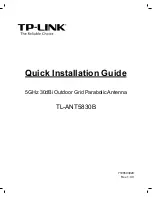
9797B-70 C-Band TXRX
Maintenance and Troubleshooting
7-3
7.2.9.
Observe Antenna Initialization
Observe the Antenna Initialization as described in the Troubleshooting section below.
7.3.
Troubleshooting
7.3.1.
Theory Of Stabilization Operation
The antenna system is mounted on a three axis stabilization assembly that provides free motion with 3
degrees of freedom. This assembly allows the inertia of the antenna system to hold the antenna pointed
motionless in inertial space while the ship rolls, pitches and yaws beneath the assembly. Three low friction
torque motors attached to each of the three free axes of the assembly provide the required force to
overcome the disturbing torque imposed on the antenna system by cable restraints, bearing friction and small
air currents within the radome. These motors are also used to re-position the antenna in azimuth and
elevation.
The Pedestal Control Unit (PCU) uses inputs from the level cage sensors to calculate the amount of torque
required in each axis to keep the antenna pointed /-0.2 degrees. The primary sensor input for each
loop is the rate sensor mounted in the Level Cage Assembly. This sensor reports all motion of the antenna to
the PCU. The PCU immediately responds by applying a torque in the opposite direction to the disturbance to
bring the antenna back to its desired position. Both the instantaneous output of the rate sensor (Velocity
Error) and the integrated output of the rate sensor (Position Error) are used to achieve the high pointing
accuracy specification.
The calculated torque commands are converted to a 5 volt differential analog signal by a Digital to Analog
converter (D/A) and sent to each of three Brush-Less Servo Amplifiers. These amplifiers provide the proper
drive polarities and commutation required to operate the Brush-Less DC Servo Motors in torque mode. The
Torque acting on the mass of the antenna cause it to move, restoring the rate sensors to their original
position, and closing the control loop.
Since the rate sensors only monitor motion and not absolute position, a second input is required in each axis
as a long term reference to keep the antenna from slowly drifting in position. The Level and Cross Level
reference is provided by a two axis tilt sensor in the level cage assembly. The Azimuth reference is provided
by combining the ships gyro compass input and the antenna relative position.
7.3.2.
Antenna Initialization (Series 97B & Series 00 )
Turn the pedestal power supply ON. The brakes on the Elevation and Cross-Level motors will release.. Brake
release power supply control circuit supplies 24 VDC to the brakes initially (5-10 seconds) and then reduces
the voltage to 12VDC. The PCU will initialize the stabilized portion of the mass to be level with the horizon
and at a prescribed Azimuth and Elevation angles. The antenna will go through the specific sequence of steps
(listed below) to initialize the level cage, elevation, cross-level and azimuth to predetermined starting
positions.
Initialization is completed in the following phases, each phase must complete properly for the antenna to
operate properly (post-initialization). Observe the Initialization of the antenna pedestal.
Step 1. The level platform motor drives the Level Cage CW, issuing extra steps to assure that the
cage is all the way to the mechanical stop. Then the Level Cage will be driven exactly 45.0 degrees
CCW.
Step 2. Elevation axis then activates - Input from the LV axis of the tilt sensor is used to drive the
Elevation of the equipment frame to bring the tilt sensor LV axis to level. This step takes
approximately 10 seconds and will result in the dish being at 45.0 degrees in elevation. The level
cage may still be tilted left or right at this time.
Step 3. Cross-Level axis activates - Input from the CL axis of the tilt sensor is used to drive Cross-
Level of the equipment frame to bring the cross-level axis of the tilt sensor to level (this results in
the tilt of the Cross-Level Beam being level). This step takes approximately 10 seconds.
Step 4. Azimuth axis activates - Antenna drives CW in azimuth until the “Home Flag” signal is
produced. This signal is produced by a Home Switch hitting a cam (or by a Hall Effect sensor in close
proximity to a Magnet). After another 10 second wait, the antenna will report its version number at
the Antenna Control Unit (ACU).
This completes the phases of initialization. At this time the antenna elevation should 45.0 degrees and
Relative azimuth should be at home flag (home switch engaged on the home flag cam).
Содержание 9797B-70 C-Band TX/RX
Страница 3: ......
Страница 4: ......
Страница 5: ......
Страница 6: ......
Страница 22: ...Basic System Information 9797B 70 C Band TXRX 3 8 This Page Intentionally Left Blank ...
Страница 40: ...Setup 9797B 70 C Band TXRX 5 12 This Page Intentionally Left Blank ...
Страница 66: ...Maintenance and Troubleshooting 9797B 70 C Band TXRX 7 24 This Page Intentionally Left Blank ...
Страница 72: ...9797B 70 Technical Specifications 9797B 70 C Band TXRX 8 6 This Page Intentionally Left Blank ...
Страница 74: ...Drawings 9797B 70 C Band TXRX 9 2 This Page Intentionally Left Blank ...
Страница 76: ......
Страница 79: ......
Страница 81: ......
Страница 82: ......
Страница 84: ......
Страница 85: ......
Страница 87: ......
Страница 88: ......
Страница 90: ......
Страница 98: ......
Страница 100: ......
Страница 101: ......
Страница 106: ......
Страница 108: ......
Страница 110: ......
















































